Zoom has undeniably transformed the way we connect, collaborate, and work. From bustling boardrooms to cozy living rooms, this video conferencing giant has become a household name, especially after the dramatic shift to remote work and online interactions.
Understanding Zoom statistics—its user base, revenue, and market dominance—becomes even more crucial for anyone looking to leverage its power.
Zoom’s Dominance: A Snapshot of 2025
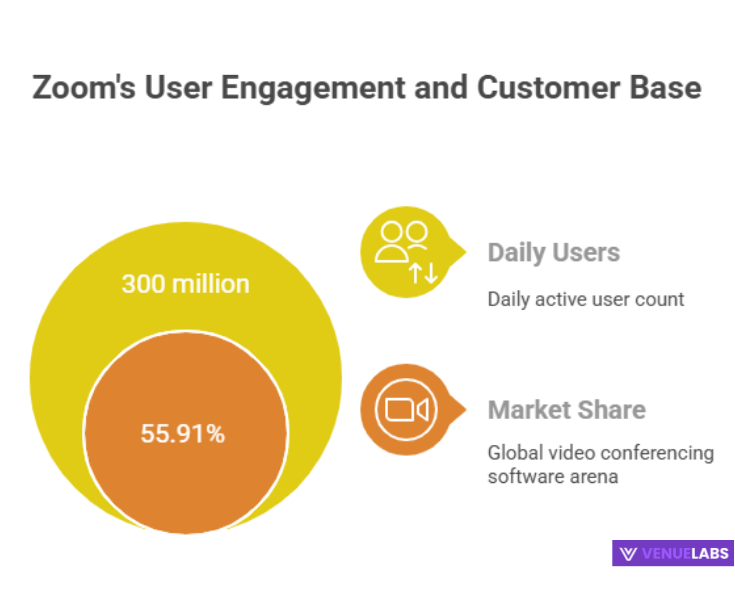
With an impressive 300 million daily active users, Zoom continues to solidify its position as a global leader in video conferencing.
The platform commands a significant 55.91% market share in the global video conferencing software arena. This immense popularity isn’t just about casual calls; it translates into substantial financial success.
In fiscal year 2024, Zoom reported a robust annual revenue of 4.6 billion.
Let’s dive into the numbers that paint a clearer picture of Zoom’s journey and its continued growth.
The Rise of a Giant: Daily Active Users
Zoom’s user growth has been nothing short of extraordinary. Before the pandemic struck, on December 31, 2019, Zoom had 10 million daily active users.
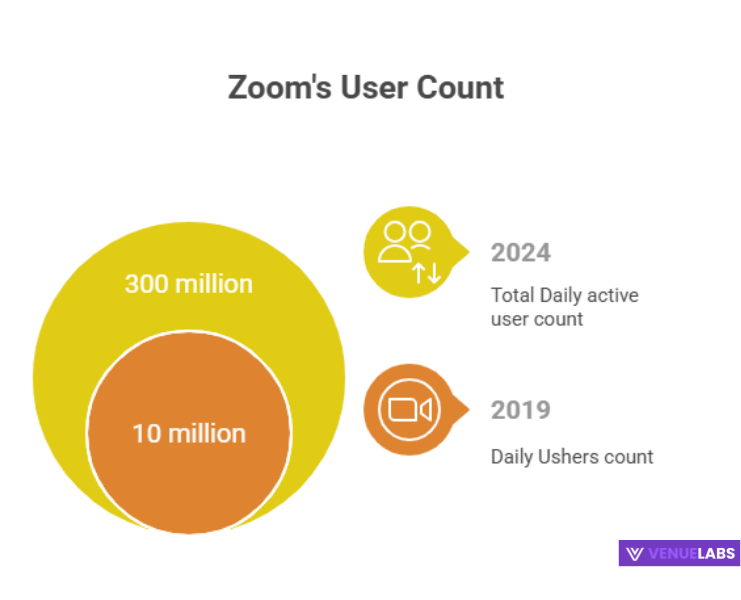
Fast forward to April 21, 2020, and that number skyrocketed to 300 million. As of January 2024, Zoom maintains over 300 million daily active users, a staggering 2900% increase from its pre-pandemic figures.
This rapid expansion highlights its critical role during a period of unprecedented global change.
Table 1: Number of Zoom Daily Active Users
| Year | Number of Zoom Daily Active Users |
| December 31, 2019 | 10 million |
| March 31, 2020 | 200 million |
| April 21, 2020 | 300 million |
| January 2024* | 300 million+ |
Source: Business Insider.
Zoom’s Financial Powerhouse: Revenue Growth
Zoom’s financial performance showcases its ability to convert a massive user base into significant revenue. The platform’s revenue surged during the pandemic years and, while the growth rate has normalized, it continues to be a formidable player. In Q1 fiscal year 2025, Zoom reported revenue of $1.175 billion.
Table 2: Revenue Generated by Zoom Over the Years
| Fiscal Year | Revenue Generated by Zoom (in millions) |
| Q1 2025 | $1,175 |
| 2024 | $4,665 |
| 2023 | $4,392.96 |
| 2022 | $4,099.86 |
| 2021 | $2,651.37 |
| 2020 | $622.69 |
| 2019 | $330.52 |
Source: Business of Apps
Leading the Pack: Zoom’s Market Share
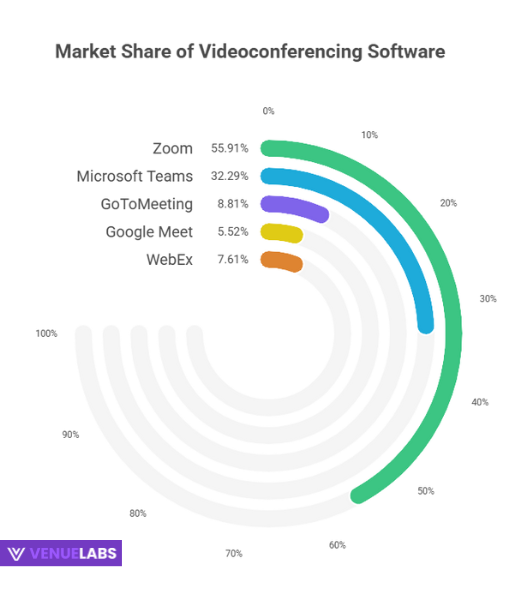
Zoom doesn’t just have many users; it dominates the market. With 55.91% of the global videoconferencing software market, Zoom clearly leads its competitors.
Its nearest rival, Microsoft Teams, holds a 32.29% market share, indicating a significant gap. This market leadership stems from its user-friendly interface, robust features, and scalability.
Table 3: Market Share of Videoconferencing Software (as of 2023)
| Video Conferencing Software | Market Share of Videoconferencing Software (as of 2023) |
| Zoom | 55.91% |
| Microsoft Teams | 32.29% |
| GoToMeeting | 8.81% |
| Google Meet | 5.52% |
| WebEx | 7.61% |
| RingCentral | 5.31% |
| FaceTime | 2.16% |
| Skype | 1.41% |
| Facebook Messenger | 0.75% |
| Bluejeans | 0.31% |
Source: Statista
- Also read about: GoToMeeting VS Zoom
Business Adoption: Zoom’s Enterprise Footprint

Zoom’s success isn’t just about individual users; businesses actively embrace it for their critical communications. A staggering 504,900 businesses worldwide rely on Zoom.
This includes 70% of Fortune 100 companies and over 50% of Fortune 500 companies. Even more impressively, 85% of the Forbes Cloud 100, the world’s top private companies, leverage Zoom.
Eight out of ten of the largest US banks and over half of the world’s largest banks utilize Zoom to connect with their growing digital clientele.
Zoom also boasts 509,800 customers with more than 10 employees as of 2022, a substantial increase from 81,900 in 2020. This segment is particularly vital, as 64% of Zoom’s revenue comes from customers with more than 10 employees.
Furthermore, Zoom has over 2,278 business customers that contribute more than $100,000 annually. As of July 2021, over 22% of Zoom’s quarterly revenue originated from these large organizations, with the average large enterprise client contributing $108,529 in annual revenue. This growing number of high-value enterprise clients demonstrates Zoom’s strong appeal to larger organizations and its ability to retain them.
Table 4: Zoom Customers With More Than 10 Employees
| Year | Zoom Customers With More Than 10 Employees |
| 2022 | 509,800 |
| 2020 | 467,100 |
| 2019 | 81,900 |
| 2018 | 25,800 |
| 2017 | 10,900 |
Table 5: Number of Customers Contributing $100K+ Annually to Zoom’s Revenue
| Year | Number of Customers Contributing $100K+ |
| July 2021 | 2,278 |
| 2021 | 1,644 |
| 2019 | 641 |
| 2018 | 344 |
| 2017 | 143 |
The Power of Connection: Meeting Minutes and Webinars
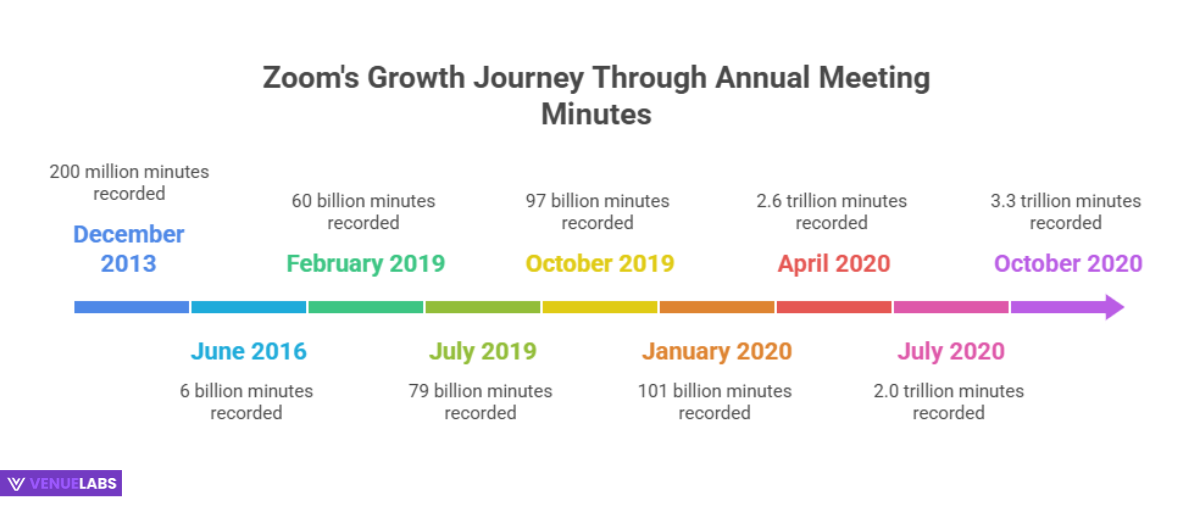
Zoom isn’t just about logging in; it’s about active engagement. The platform hosts an astounding 3.3 trillion meeting minutes each year, representing a 65% increase from the previous year.
This metric, calculated by annualizing the total minutes from the final month of each quarter, highlights the sheer volume of conversations and collaborations happening on Zoom.
Table 6: Zoom Annual Meeting Minutes Recorded
| Quarter, Fiscal Year | Annual Meeting Minutes |
| October 2020 | 3.3 trillion |
| July 2020 | 2.0 trillion |
| April 2020 | 2.6 trillion |
| January 2020 | 101 billion |
| October 2019 | 97 billion |
| July 2019 | 79 billion |
| February 2019 | 60 billion |
| June 2016 | 6 billion |
| December 2013 | 200 million |
Beyond one-on-one and group meetings, Zoom also serves as a crucial platform for large-scale events. It has recorded over 45 billion annual webinar minutes, marking a 7.14% increase from the previous year.
This surge, particularly noticeable in April 2020 with a 14-fold increase from the prior quarter, demonstrates its adaptability for educational, marketing, and corporate event needs.
Table 7: Zoom Annual Webinar Minutes Growth
| Month, Year | Annual Webinar Minutes |
| October 2020 | 45 billion + |
| July 2020 | 42 billion |
| April 2020 | 42 billion |
| January 2020 | 3 billion |
| October 2019 | 3 billion |
| July 2019 | 2 billion |
Global Reach: Zoom Downloads and Mobile Dominance
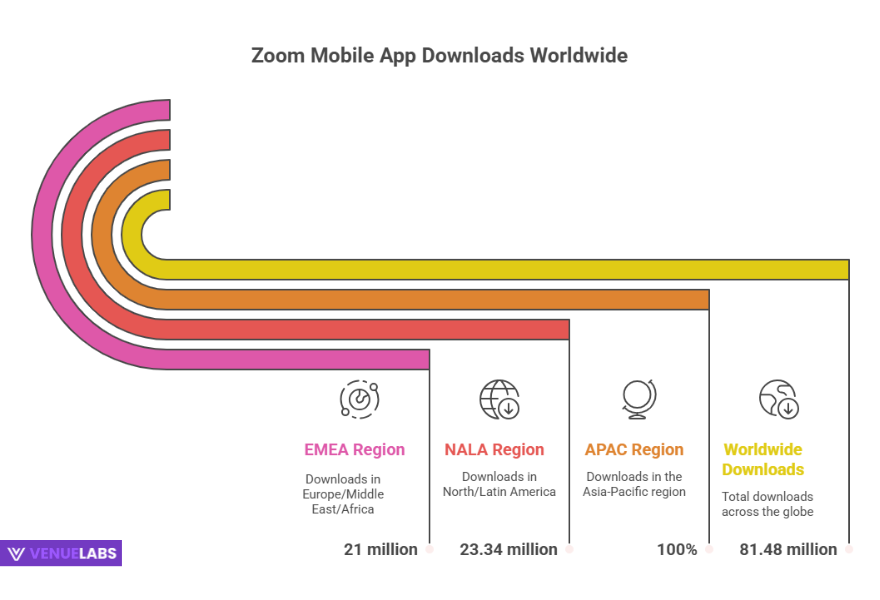
Zoom’s accessibility across devices has been a key factor in its widespread adoption. In 2022, Zoom recorded 37 million downloads in the United States, making it the most downloaded app in the country. Microsoft Teams, its closest competitor, had 25 million app downloads in the same period.
The mobile app has been a significant driver of this growth. In the first half of 2023, the Zoom mobile app saw 81.48 million downloads worldwide.
The Asia-Pacific (APAC) region led with 37.14 million downloads, followed by North America and Latin America (NALA) with 23.34 million, and Europe, the Middle East, and Africa (EMEA) with 21 million.
Table 8: Zoom App Downloads by Region Over the Years
| Year | Number of Zoom App Downloads In The APAC Region | Number of Zoom App Downloads In The EMEA Region | Number of Zoom App Downloads In NALA Region |
| 2023 (first half) | 37.14 million | 21 million | 23.34 million |
| 2022 | 90.58 million | 45.5 million | 51.15 million |
| 2021 | 161.65 million | 79.67 million | 86.15 million |
| 2020 | 297.42 million | 182.42 million | 260.42 million |
Table 9: Number of Zoom App Downloads Recorded Worldwide Over the Years
| Year | Number of Zoom App Downloads Recorded Worldwide |
| 2023 (first half) | 81.48 million |
| 2022 | 187.23 million |
| 2021 | 324.47 million |
| 2020 | 740.26 million |
Beyond Meetings: Zoom Phone’s Ascent
Zoom has diversified its offerings beyond just video meetings. Zoom Phone, launched in 2019, allows users to make phone calls using cloud technology for audio conferencing.
It has rapidly gained traction, selling over 7 million phone seats across 44 countries in less than five years. This demonstrates Zoom’s strategic expansion into a broader communication platform, appealing particularly to multinational companies that require seamless global connectivity. Over 10,700 Zoom Phone customers employ more than 10 staff, showcasing its strong appeal to businesses.
The Human Element: Zoom’s Workforce
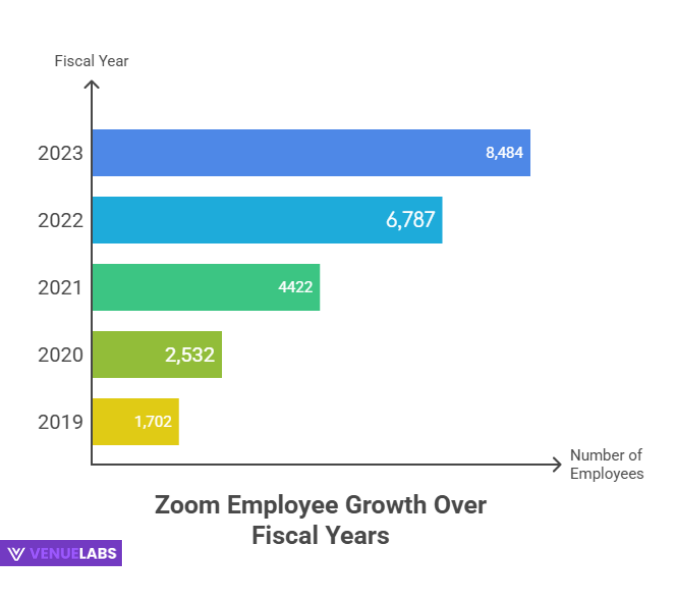
As a major tech company, Zoom employs a significant workforce. The total number of employees working at Zoom reached 8,484 in 2023, a 25% increase from the previous fiscal year.
However, this number is expected to stabilize or potentially decrease in the current fiscal year as Zoom optimizes operations in response to evolving market conditions and the return to offline work for many organizations.
Table 10: Total Number of Zoom Employees Recorded Over the Past Fiscal Years
| Fiscal Year | Number of Zoom Employees |
| 2023 | 8,484 |
| 2022 | 6,787 |
| 2021 | 4,422 |
| 2020 | 2,532 |
| 2019 | 1,702 |
A notable demographic insight is that 53.4% of Zoom’s employees are White by race. Of the total workforce, 4,588 Zoom employees are in the United States, with the remaining 3,896 employees in international locations as of 2023.
Table 11: Ethnicity of Zoom Employees
| Ethnicity | Share of Employees Belonging to the Ethnicity |
| White | 53.40% |
| Asian | 22.40% |
| Hispanic | 6.50% |
| Black | 4.90% |
| Pacific Islanders/Hawaiian | 0.50% |
| Alaska Native/Native American | 0.3% |
Navigating the Landscape: Insights from Quora and Reddit
Beyond the numbers, active users on platforms like Quora and Reddit often share valuable insights and raise questions that indicate current trends and concerns. Recent discussions often revolve around:
- Hybrid Work Solutions: Users frequently ask about Zoom’s capabilities in truly hybrid environments, integrating seamlessly with in-office hardware and offering equitable experiences for both remote and in-person attendees. This suggests a demand for more advanced features that cater to the evolving nature of work.
- AI Integration: The rise of AI has users curious about Zoom’s AI functionalities, such as automated meeting summaries, real-time transcription, and smart assistant features. People want to know how AI can enhance productivity and reduce meeting fatigue.
- Security and Privacy: With increased reliance on virtual communication, questions about Zoom’s security measures, end-to-end encryption, and data privacy remain a consistent theme. Users want reassurance that their conversations and data are protected.
- Feature Parity Across Devices: While the mobile app is popular, users often inquire about consistency in features and performance between desktop and mobile versions, especially for advanced functionalities.
- Niche Use Cases: Discussions sometimes highlight specific, innovative uses of Zoom beyond traditional meetings, such as virtual events, online fitness classes, or even remote medical consultations, showcasing its versatility.
These discussions underscore that while core functionality is important, users are actively seeking enhanced, secure, and intelligent features that support a diverse range of communication needs in a post-pandemic world.
How You Can Benefit from Zoom’s Continued Growth
Understanding these statistics and user trends empowers you to leverage Zoom for your own advantage:
- For Businesses:
- Reach a Wider Audience: With 300 million daily active users, Zoom offers unparalleled reach for meetings, webinars, and online events. If you are selling a product or service, Zoom can connect you with potential customers globally.
- Enhance Collaboration: Zoom’s suite of features, including screen sharing, breakout rooms, and virtual whiteboards, fosters efficient team collaboration, regardless of physical location.
- Reduce Costs: Implementing Zoom can significantly cut down on travel expenses and the overhead associated with physical meeting spaces.
- Future-Proof Your Operations: As hybrid work models become the norm, adopting Zoom ensures your business remains agile and connected.
- For Educators:
- Deliver Engaging Lessons: Interactive features can transform virtual classrooms, making learning more dynamic and accessible.
- Connect with Students Globally: Educational institutions can reach students anywhere in the world, expanding their reach and impact.
- Facilitate Parent-Teacher Conferences: Easy-to-use video calls simplify communication between educators and parents.
- For Individuals:
- Stay Connected: Zoom helps maintain strong bonds with family and friends, especially over long distances.
- Access Opportunities: Attend online courses, workshops, and job interviews from the comfort of your home.
- Participate in Communities: Join interest groups, clubs, and support networks online.
FAQs About Zoom Statistics
1. How many daily active users does Zoom currently have?
Zoom currently has over 300 million daily active users, a figure that includes both free and paid accounts, demonstrating its widespread use for various purposes.
2. What is Zoom's market share in the video conferencing industry?
Zoom holds a commanding 55.91% of the global videoconferencing software market, making it the dominant platform in the industry, significantly ahead of its closest competitors.
3. How much revenue did Zoom generate in fiscal year 2024, and what are the projections for 2025?
Zoom generated an annual revenue of $4.66 billion in fiscal year 2024, and for the ongoing fiscal year 2025, the company anticipates revenue to be in the range of $4.6 billion.
4. Are businesses still heavily relying on Zoom, or has usage decreased with the return to offices?
Businesses continue to heavily rely on Zoom, with 504,900 businesses worldwide using the platform, including a majority of Fortune 100 and Fortune 500 companies; while the growth rate has normalized, its integration into enterprise operations remains strong.
5. What are some emerging trends or features users are looking for in Zoom?
Users are increasingly interested in Zoom’s capabilities for truly hybrid work environments, enhanced AI integrations such as automated summaries, robust security and privacy features, and consistent functionality across all devices, including mobile.
Also Read:
- Internet User Statistics
- Video Marketing Statistics
- Google Searches Statistics
- eLearning Statistics
- LinkedIn Statistics
Looking Ahead to 2025: Zoom’s Evolving Role
Zoom’s journey from a startup to a global communication behemoth is a testament to its adaptability and understanding of user needs.
While the explosive growth seen during the initial pandemic phase has naturally slowed, the platform continues to innovate and expand its offerings, particularly with features like Zoom Phone and increased integration with AI.
The focus for 2025 and beyond will likely be on refining the hybrid work experience, enhancing security, and seamlessly integrating advanced AI capabilities to make virtual interactions even more productive and intuitive.
Zoom isn’t just a video conferencing tool; it’s a vital component of the modern digital ecosystem, connecting millions of people and businesses worldwide. Its ability to continuously adapt and meet the demands of a dynamic global workforce will determine its trajectory in the coming years.
